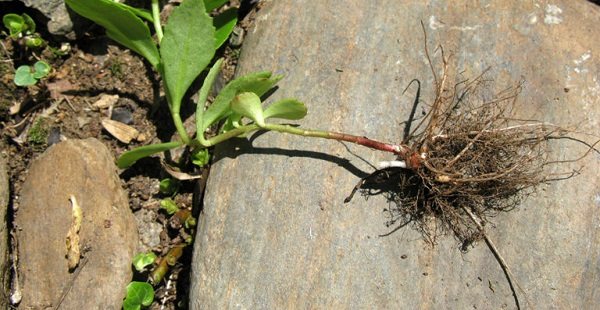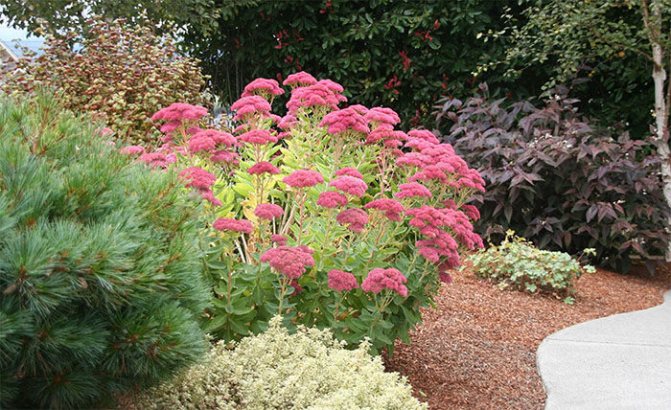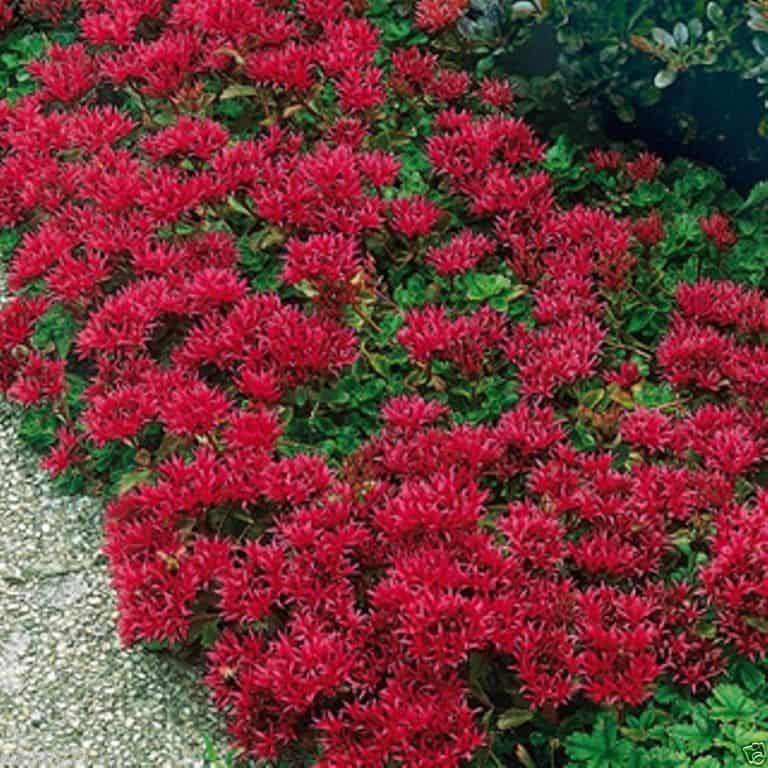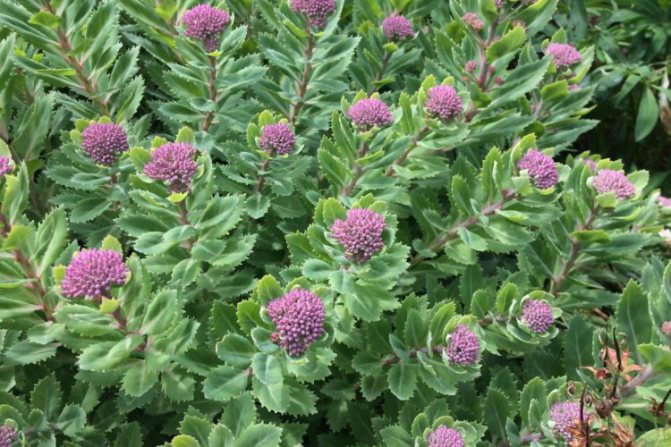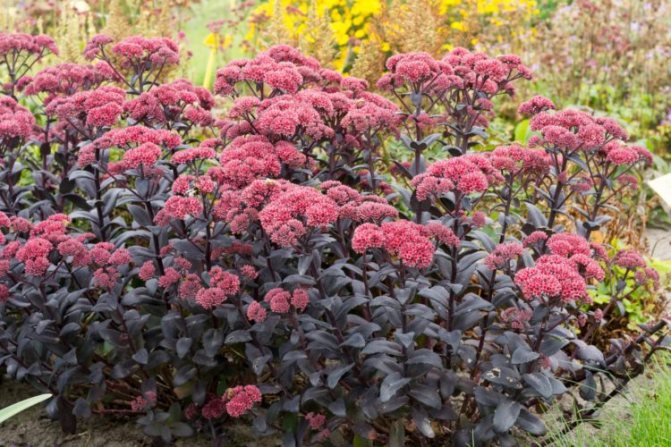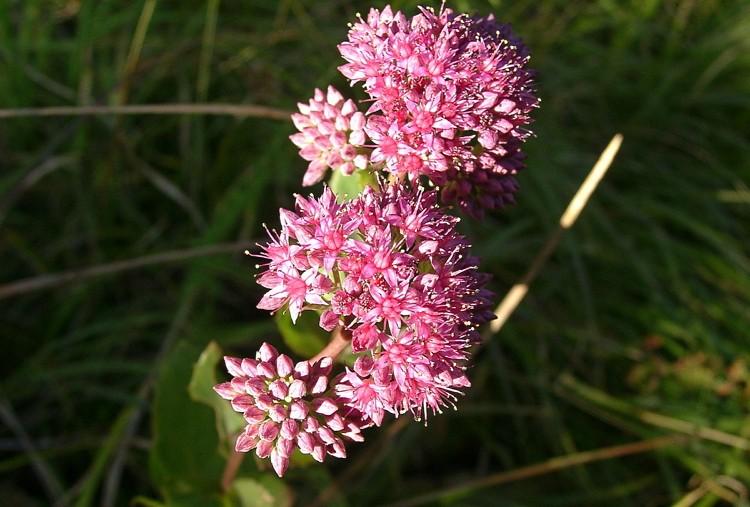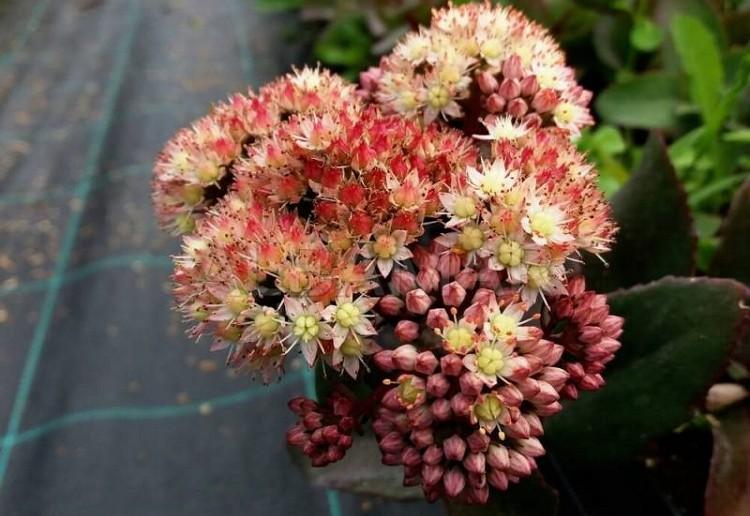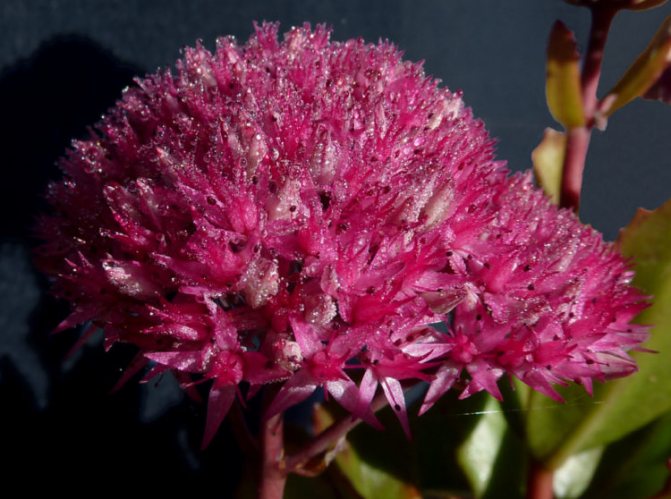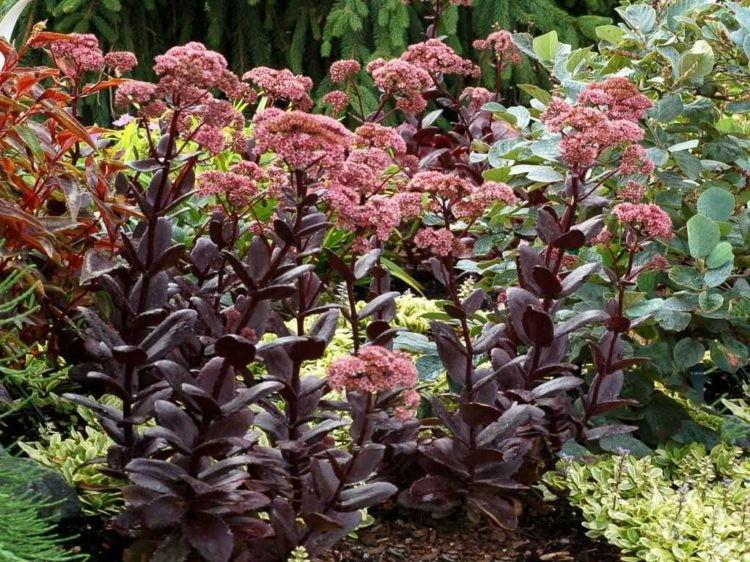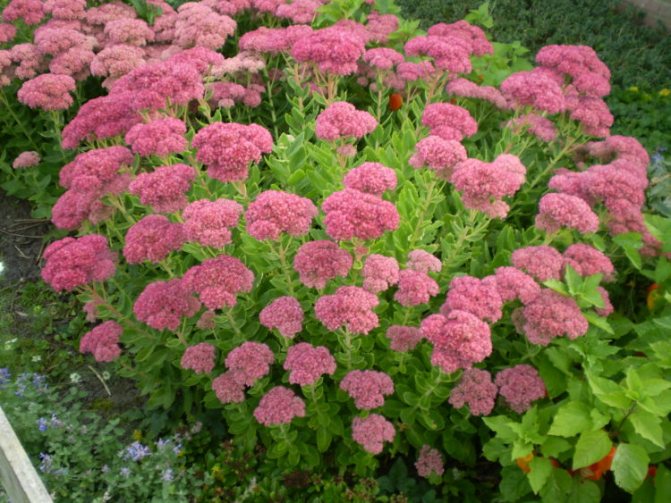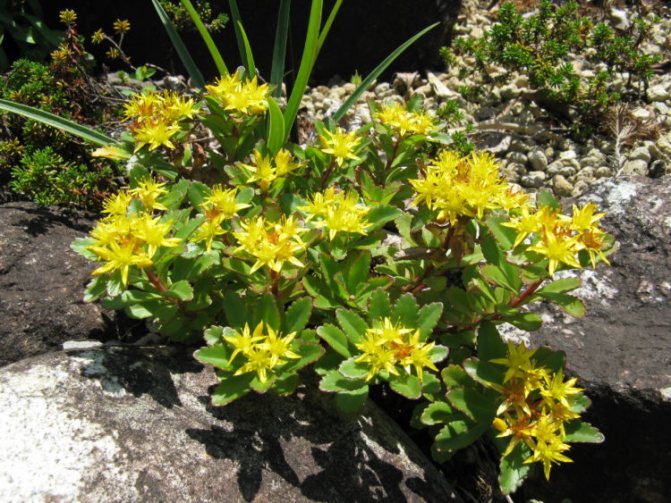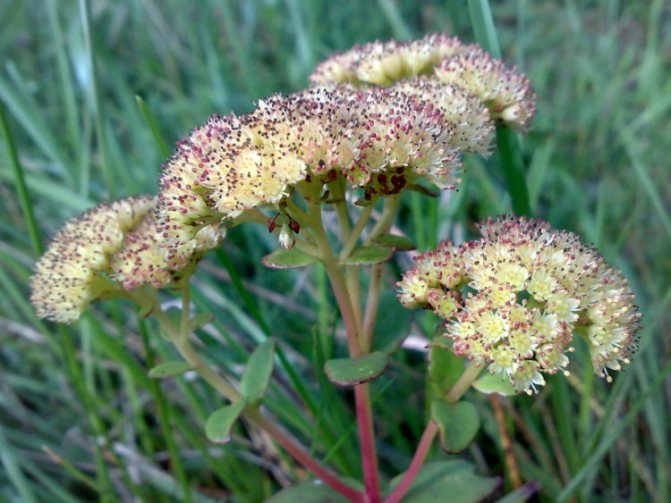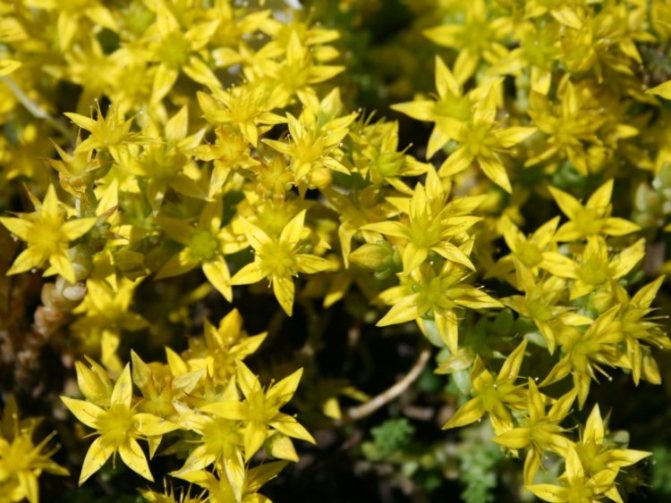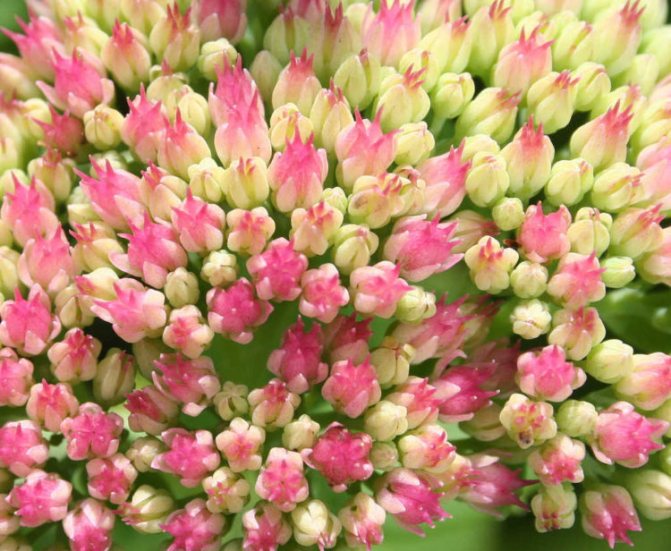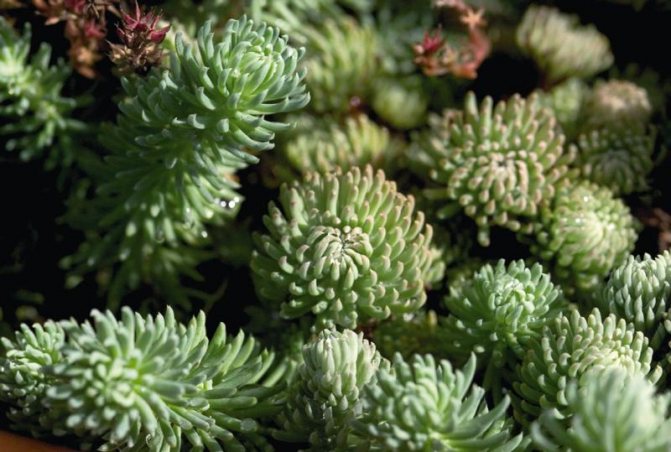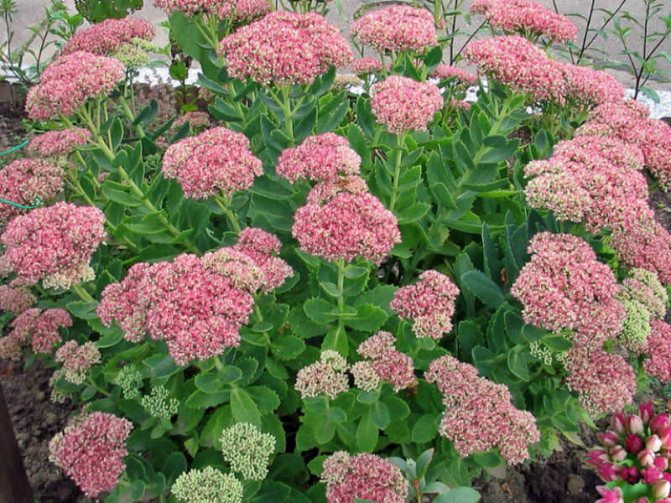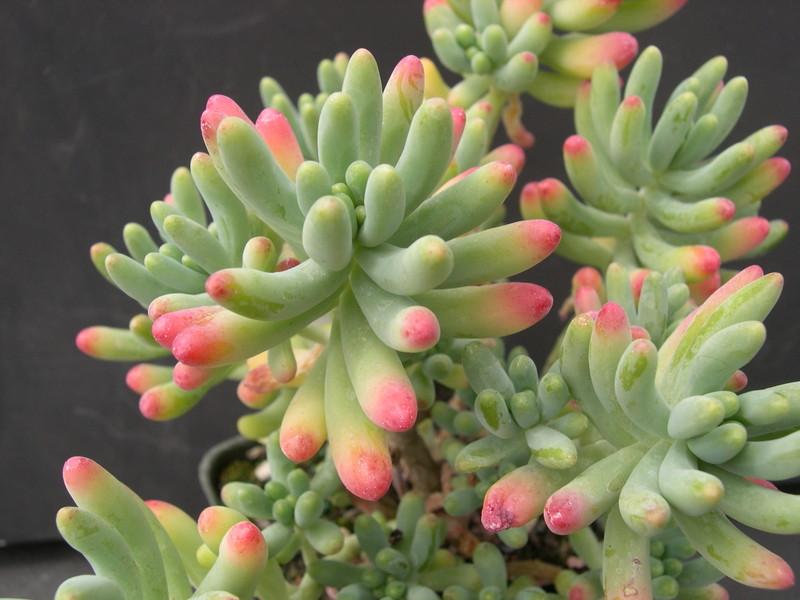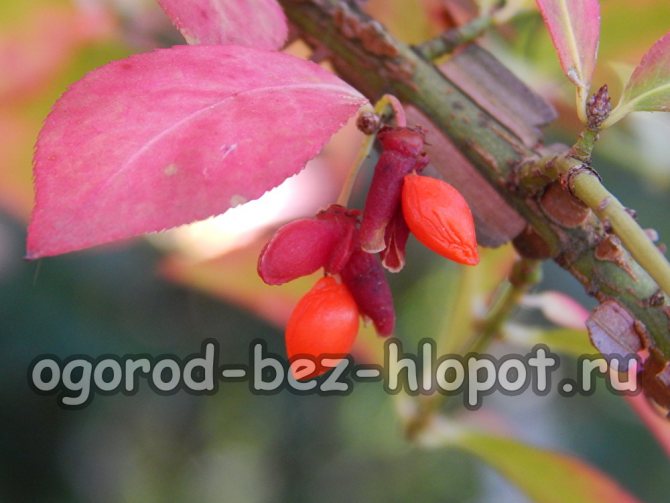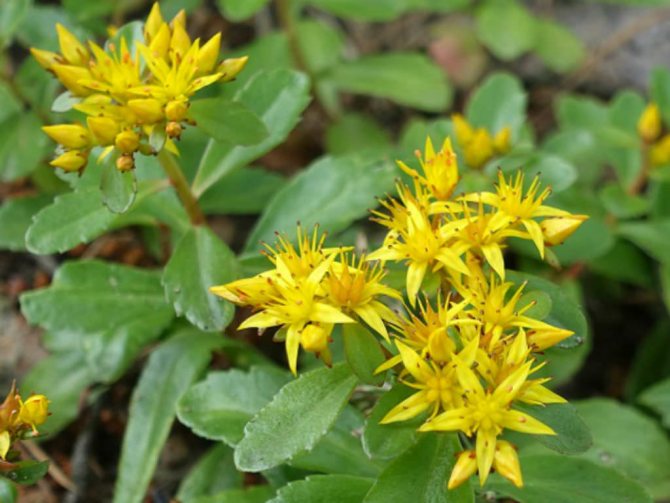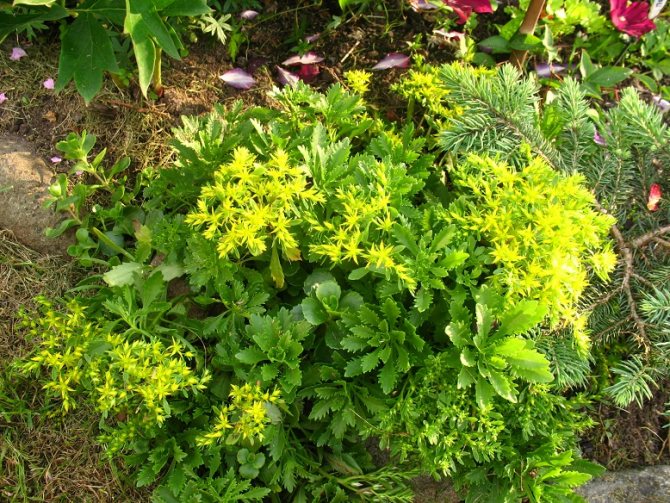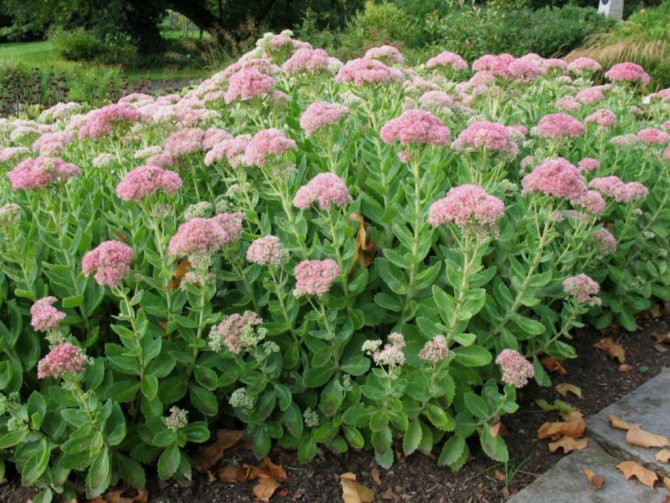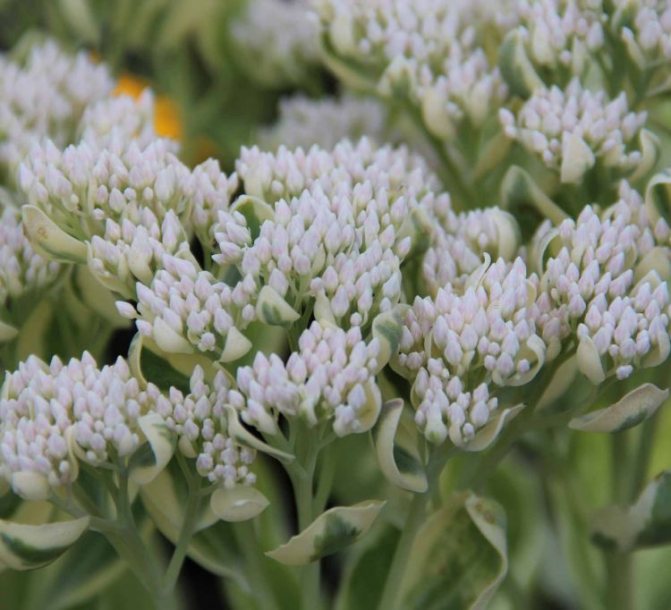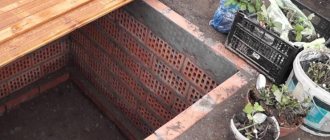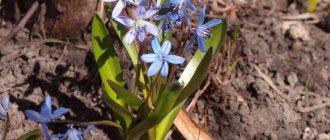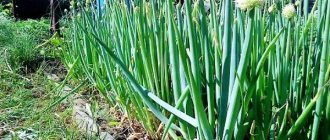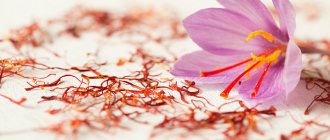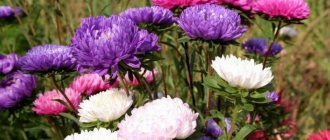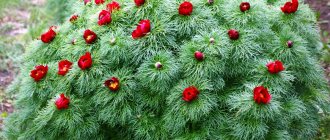Sedum or sedum is a succulent plant that grows well on soil that does not have a lot of nutrients. In nature, it occurs in the mountains, near stones, on the outskirts of roads. Due to the fact that sedum has the ability to accumulate moisture, it can grow in the areas of summer residents who cannot provide regular watering due to trips to the country only on weekends and on holidays. In this case, it will be enough to provide him with a well-lit place. They are used in decorating flower beds, as it can grow both with a large carpet and in the form of individual bushes. The flowering period is different for each variety, but sedum often blooms all summer. Some varieties are able to delight with flowering until late autumn.
Popular varieties
Each of the sedum varieties has a zest and is in demand among gardeners. However, there are varieties that have been popular for over 5 years.
Kamchatka sedum
A loose bush, consisting of erect shoots 30-35 cm high. The length of the dark green elongated leaves is 4-5 cm. The edges at the base of the plate are even, and on the opposite, they are serrated. Yellow flowers up to 2 cm in diameter form dense inflorescences-shields. The size of one umbrella is 11-13 cm. It enters the flowering phase in June, and leaves in 2-3 weeks.
Sedum caramel Kamchatka
Perennial plant with vertical stems 20 cm high. Ellipsoid leaves have a blunt edge near the petiole and serrated at the top. Small flowers are colored orange-yellow. Shield-shaped inflorescences form in June and decorate plants for 25-30 days.
Sedum purple carpet
A perennial herb that was discovered in the 19th century by the German botanist M. Bieberstein. Succulent is a compact bush 15-20 cm high and 40-50 cm in diameter. Densely leafy stems creep along the ground. The bright green oblong leaves are arranged in two rows.
The plate is 5-6 cm long, 3-4 cm wide. The flowers are red with pointed petals. Sedum purple blooms for 1.5-2 months, starting in the first half of summer. Succulent Sedum purple cultivation from seeds is carried out on the same principle as all succulents.
Sedum Evers
Compact perennial shrub. By the beginning of autumn, red-brown shoots are lignified. Round small leaves are gray, thick. The flowers, painted pink, are collected in inflorescences. The flowering period begins in July and lasts about two months. In the fall, the plant throws off its leaves.
Sedum beautiful
Perennial with creeping stems. The leaf plates are thick, turgor, gray-gray. Prefers to grow in soil from leafy and turfy soil, sand (1: 1: 2). Grown in low pots.
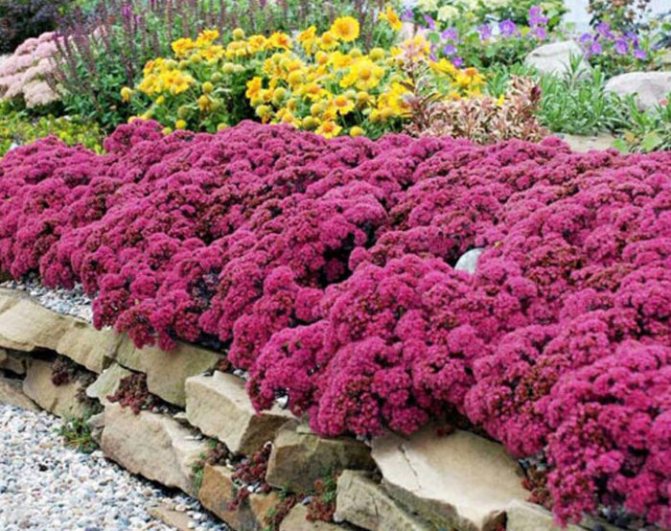
Types of stonecrops - what are available
The variety is great, hundreds of tropical and cold-resistant species are known. The most decorative of them are cultivated culturally, separated into separate genera (Ochitnik, Zhivuchnik, Petrosedum) and varieties.
Groundcover
These are creeping species that cover the soil, ranging in height from a few to 30 centimeters. The bushes spread out on the ground create the illusion of a dense covering, which makes them seem stunted.
Used to decorate alpine slides, rockeries, curbs, roofs and walls. They are planted in containers (including suspended ones).
Cornflower
Purple flowers of varying intensity, 0.5 centimeters in diameter, are strewn with gray, bluish leaves. There are red blotches on the leaves. The stems are 8-10 centimeters long. The varieties are frost-resistant, demanding for light, moisture and soil looseness. Bloom: August-September. Examples of cultivars: Rosenteppich and Rose Carpet.
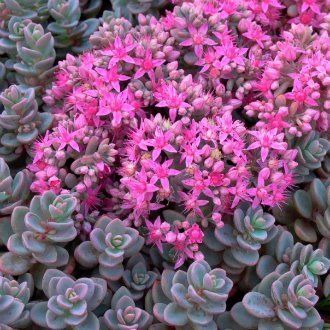

Siebold's sedum
Creeping stems, up to 25 centimeters long. It blooms with multi-colored flowers in October. It is grown in containers, on alpine slides, rockeries. Used to create topiary. Dragon, Mediovariegatum are the most common varieties.
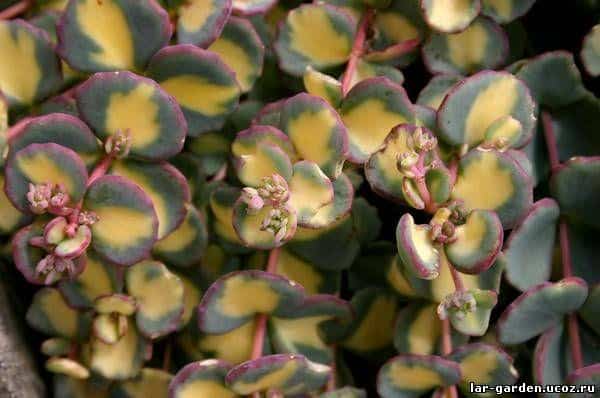

Anacampseros
Easily rooting stems spread and reach a length of 15-20 centimeters. Flowers 0.7 centimeters in diameter, varying in intensity of pink and red, appear in July-August. Bluish-gray leaves are decorative. Demanding on the composition of the soil (does not like alkalization), needs constant weeding and abundant watering.
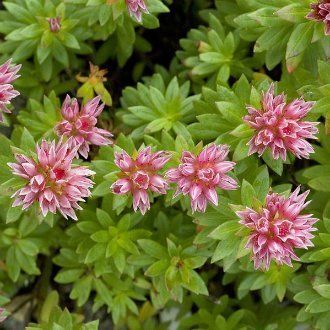

Kamchatka
The variety Variegatum is widespread. The shoots do not completely lodge, the rhizome becomes woody. Stems of 15-25 centimeters have yellow flowers with stamens during the flowering period (July-September), then scarlet fruits appear. Loves watering, partial shade.
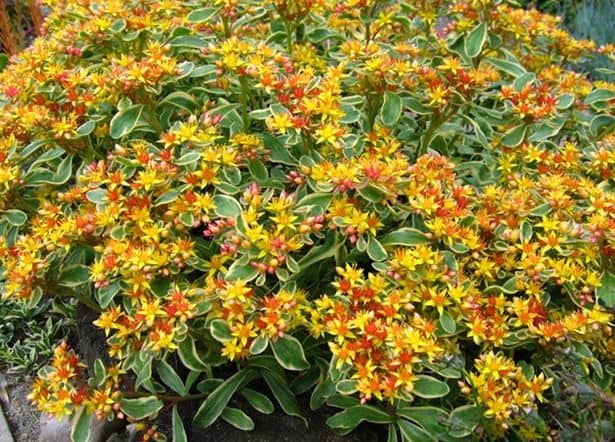

Forster sedum
The rug is 10 centimeters thick and has peduncles up to 30 centimeters high. The leaves are green, bluish, then turn red. The flowers are yellow, pink. It grows rapidly and takes over the area. Nice in containers. Watering is regular. Purpureum, Elegance are famous varieties.
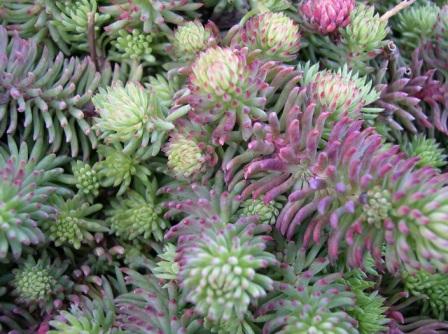

Divergent
Beautiful, very decorative. Bushes up to 5 centimeters high, flower stem 10 centimeters. Green leaves turn red in the sun, flowers are yellow, pink. This is a winter-hardy variety, unpretentious to the soil, does not like excessive watering. They green roofs, plant them in rockeries, decorate topiary.
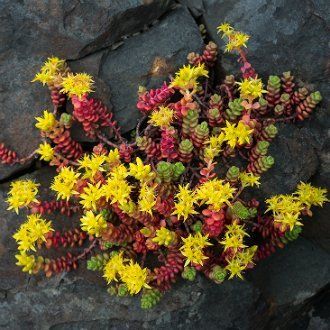

False
Loves the sun, light and partial shade, blooms in July-August. The plant is 15 centimeters high and forms covers on the soil. They decorate flower beds, mixborders, spacious containers. The leaves are green, becoming bronze, red by autumn. Flowers in various shades of pink, burgundy, red and white. Only some varieties: Elizabeth, Tricolor, Album, Leningrad White and others.
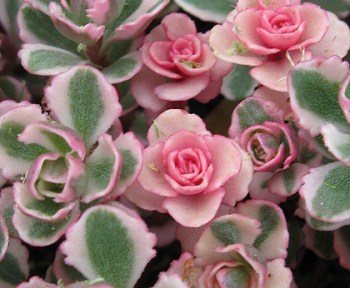

Sedum caustic
The coating is dense, solid, 5-10 centimeters high, poisonous. Green leaves, yellow flowers. Blossoming June-July. Undemanding to the conditions of detention. It tolerates winter and drought well. It is easy to weed out, it grows very quickly. Sedum caustic is a melliferous plant, interesting varieties Minus, Elegance.
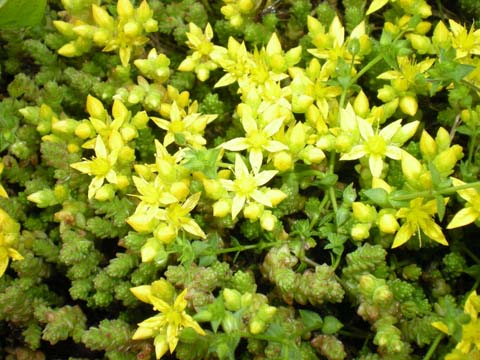

Sedum Evers
Bushes up to 40 centimeters, gray-green leaves with pink inflorescences. Grows quickly, hardy, unpretentious. Suitable for growing in rockeries, rock gardens.
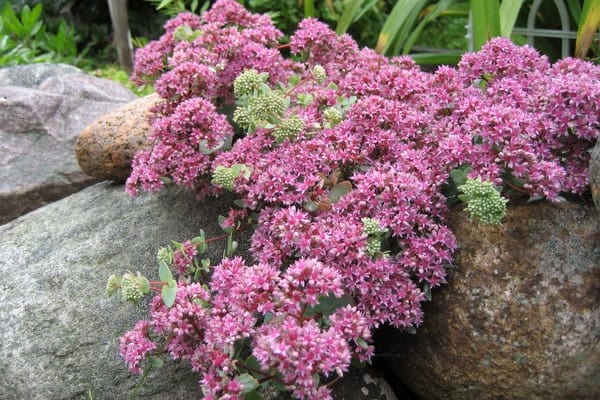

Lydian
A rare variety. Cover 4-5 centimeters. Green leaves turn red in the sun, creeping shoots have white flowers. Does not like drought, grows in partial shade. This evergreen plant will decorate borders and rockeries.
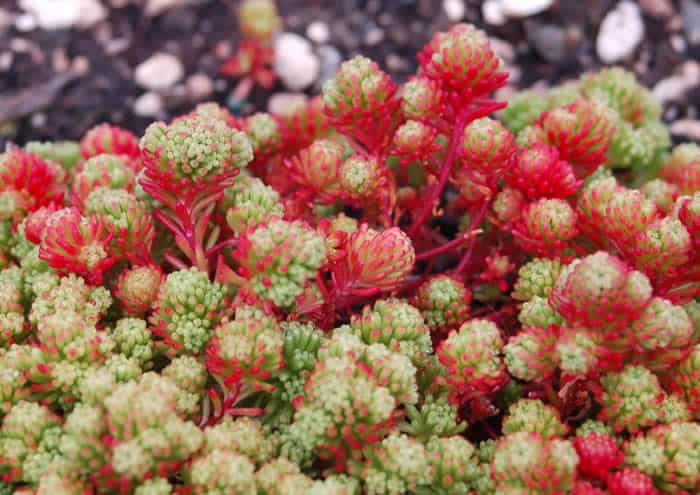

Shrubs
This is a tall species of stonecrop. Such a sedum is unpretentious in cultivation: it grows on soil poor in humus, on rocky areas. High varieties of sedum plants need more watering than creeping ones, because their root system is not covered with a continuous carpet of vegetation.
They bloom from summer to autumn, for many years in one place, they are more popular among gardeners than their undersized counterparts.
Prominent sedum
Forms a bush of 40-70 centimeters. Leaves are green, can be purple in color with a bluish tint. Flowers from white, white-pink to deep purple. Blooms in August to October, requires moderate watering. Releases air shoots, which are removed. This variety is grown in a spacious container, mixborders, single flower beds. Varieties - Iceberg, Carmen, Crystal Pink, Stephen Ward.
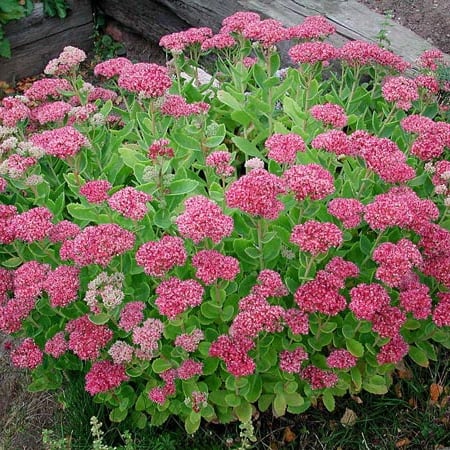

Ordinary
The bush is high, up to 80 centimeters with pink or purple flowers. The leaves are green, oval. July and August are the flowering months. Hare cabbage is grown in mixborder groups, suitable for growing in a container. Bon-Bon, Red Globe, Trafl are common sedum varieties.
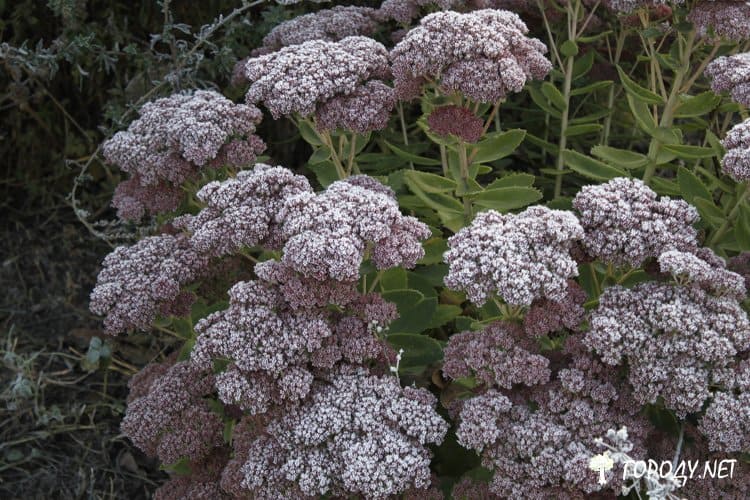

Tenacious
The shrub reaches a height of 50 centimeters. Blooms all summer. Loves shading, prefers scanty soil, unpretentious look. Watering is moderate, regular.
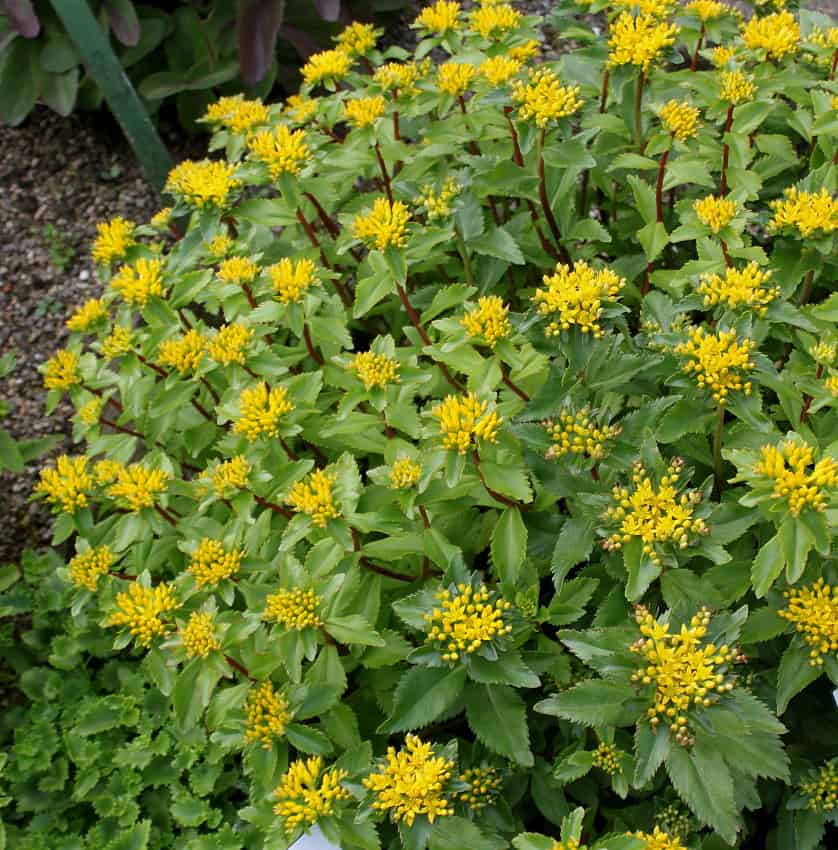

Red dot
This sedum grows up to 60 centimeters in height. Leaves are greenish-gray. Flowers of different colors: white, pinkish, pink. Late blooming in September-October. He prefers sunny places along with partial shade. Watering is moderate.
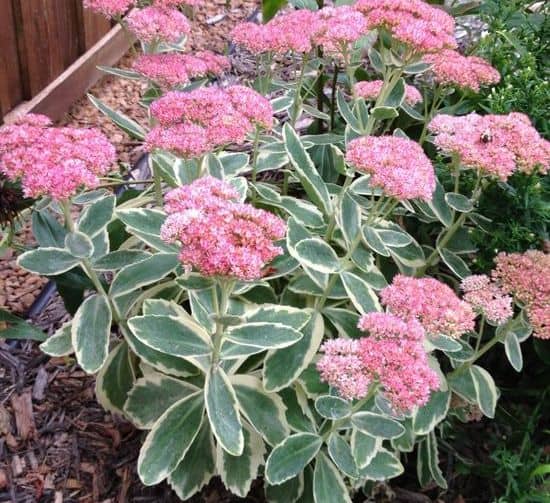

Planting sedum for seedlings
Only patient growers can do the cultivation of a succulent in a seed way. The process requires a number of manipulations, and lasts much longer than reproduction by one of the vegetative methods.
Sedum seed growing when to plant? Sedum is planted with seeds in March and the first half of April according to the following plan:
Prepare the potting soil. Mix leaf and sod land, sand and peat based on a ratio of 1: 1: 1: 1. It does not matter to which variety the sedum you like belongs to, sowing seeds for seedlings is carried out as follows:
- Put a handful of the substrate at the bottom of the plate and level it. The seeds are sown on the soil surface and sprayed with water.
- The container is placed in a bag or covered with glass and sent to the refrigerator (section for vegetables) for 2 weeks.
- Stratified seeds are sown in containers, the soil is moistened with a spray bottle. To make it easy for delicate seedlings to break through to the surface, the planting material is crushed over the surface of the substrate and sprinkled with a thin layer of sand.
- The container is covered with foil or glass.
To prevent fungi from appearing on the soil and planting material, the mini-greenhouse is ventilated from time to time. At room temperature, sedum seedlings make their way to the surface 2-4 weeks after sowing. Plants that have formed 1-2 true leaves are transplanted into separate containers.
2 weeks before the expected date of the next pick, the seedlings are hardened. Young plants will experience less stress and will take root better in a new place if they gradually increase their time in the fresh air. Hardening starts from 1-2 hours and is brought up to a day.
Landing on a permanent place is carried out in the third decade of May. When propagating sedum by seeds, keep in mind that the plant will not bloom in the first summer.
For a flower such as sedum, growing from seed is one of the most effective ways to get an exotic plant for your garden.
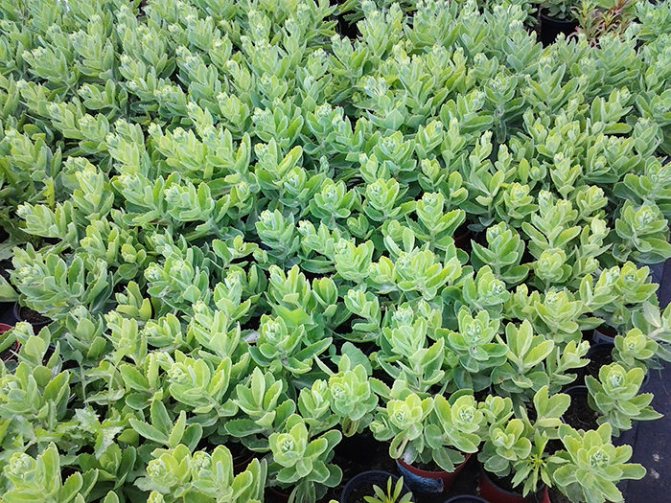

How to grow a flower at home
Bacopa Monnieri: description and properties of the plant
For the home, choose pots with low walls, wide. Each must have drainage holes.
Illumination and temperature conditions
The temperature depends on the season:
- for summer - from 25 to 28 degrees;
- for winter - from 8 to 12 degrees.
In the summer months, sedum needs a bright sun, it is placed on the south side. In winter, use additional lighting.
Watering rules and humidity
The plant is watered weekly in summer, in autumn and winter, the frequency is reduced by 2 times.
Spraying is not required, sometimes a warm shower is carried out.
Top dressing and soil quality
For normal growth, the plant requires a special mixture for cacti.
But if you wish, you can make the soil yourself by mixing sand, turf and leafy soil in equal parts.
The bottom of the container is drained, fertilizers are applied from March to August, after September the plant does not need feeding.
How to plant sedum outdoors
It depends on how the landing will be made whether the flower will take root or not. But before proceeding to the decisive manipulation, you need to carefully prepare.
How to choose a seedling
It is best to buy sedum flowers in the nursery. For planting, it is worth choosing only healthy seedlings without mechanical damage and traces of diseases and pests. The leaves should be alive with turgor, and the soil in the container should be clean.
When choosing a plant, it is worth considering the fact that low-growing varieties are more suitable for creating living carpets, and tall varieties for single plantings.
In our nursery in Tatarstan, you can buy high quality sedum seedlings for every taste. The company delivers orders throughout Russia, so you can buy sedum in Moscow or any other city if you are a wholesale buyer.
Seat selection
Like most succulents, sedum grows well on sandy and rocky soils. Despite this, the plant can live on any other soil that allows water to pass through well. You should not plant a flower in an area with swampy soils or in a lowland where water often accumulates.
As for lighting, it is better to plant sedum in a well-lit place, unless otherwise is written in the description of the purchased specimen. It is undesirable for shrubs and trees to grow nearby.
Sedum, planted in the shade, quickly loses its decorative effect. The leaf plates become thinner, and the stems become elongated.
Soil preparation
Most sedum varieties are not demanding on the composition of the soil. At the same time, some of the ground cover varieties prefer to grow in garden soil rich in trace elements, while the rest thrive in loams or sandstones.
For example, sedum sedum purple carpet belongs to the first category, prominent sedum - to the second. Therefore, before buying a stonecrop you like, you need to clarify whether it will be possible to fulfill the requirements of the plant.
A universal soil mixture for succulent is prepared from leafy and sod land, sand, rotted manure mixed in a 1: 1 ratio. A handful of wood ash is added to the finished substrate.
Landing dates
Sedum is planted in the second decade of May, when the risk of recurrent frosts is reduced to zero. In the southern regions, the favorable time comes earlier, and in the northern - later than the specified date.
A flower is planted following this scheme:
- At the chosen place, holes are dug with a diameter of 50 cm and a depth of 20 cm. So that the plants do not interfere with each other's growth, 20 cm of free space is left between them.
- A layer of drainage material is laid at the bottom of the planting pit: pebbles, gravel or broken brick. This will improve the drainage of water and prevent the growth of fungus.
- The well is 2/3 filled with potting soil.
- The seedlings are set in the center and the spread roots are sprinkled with earth.
- The plant is watered abundantly.
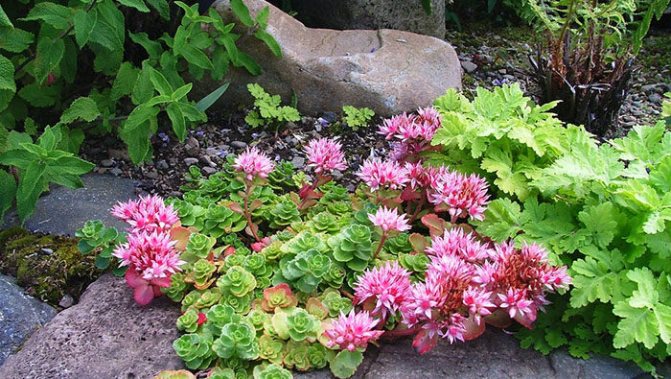

Transfer
A young plant needs a transplant once every couple of years, an adult - once every 3-4 years. The sedum plant easily tolerates transplants, so it can be transplanted at any time of the year and even during flowering. The main thing is to handle it carefully, because the stems of the sedum are quite brittle, and the leaves tend to fall off with any inaccurate touch. Moisten the soil a little before transplanting.
For the first time, it is better to hold the transplanted bush in partial shade and not disturb. The next watering is done only after the topsoil is completely dry 1 cm deep.
After transplanting, the plant may shed its leaves. It's okay, this is normal, new ones will grow soon.
Pot
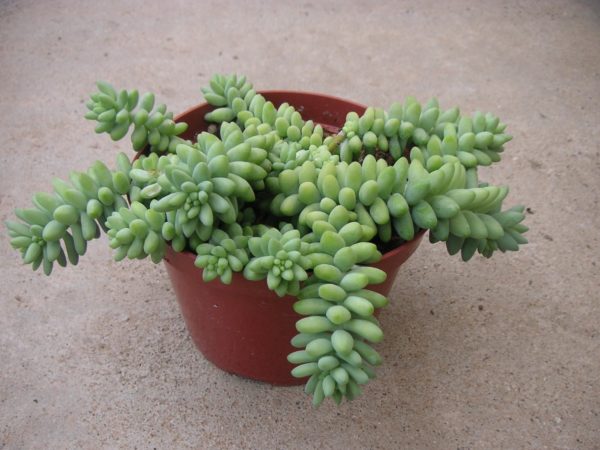

Stonecrop has a small root system, so a low, wide pot with drainage holes is perfect. It is not necessary to change it to a larger one with each transplant, because the roots of the plant develop slowly and do not take up much space. A drainage layer should be placed on the bottom of the pot. It is desirable that it be expanded clay, but pebbles are also suitable.
It may be interesting: Pedilanthus - features of home care
Priming
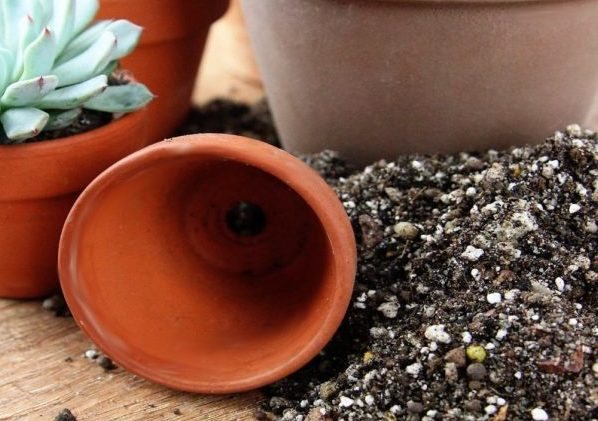

Purchased succulent soil is suitable for sedum. If desired, you can cook it yourself. There are two suitable options:
- Stir in 1 teaspoon of leafy earth, turf and river sand. Add a small amount of bricks and charcoal pieces.
- Mix 2 tsp peat, 1 tsp rotted foliage, 1 tsp sand.
Sedum planting and care: propagation by vegetative methods
You can also get new plants using cuttings. To do this, a cutting is cut from the center of a healthy mature shoot, so that 2-3 cm remain above the upper and lower buds.
The cuttings are planted in a loose moist substrate and, as necessary, sprayed with a spray bottle.
During transplantation, the sedum is propagated by dividing the bush. The dug out plant is divided into 3-4 parts. The damaged roots are sprinkled with activated carbon powder and placed in a dark, dry place for 2-3 hours. After that, the bushes are planted in separate holes in a sunny area.
Diseases and pests
The sedum plant is rarely exposed to diseases and pests if it is looked after according to all the rules. Therefore, if you find that your instance is having a problem, review its containment terms. Now we will tell you what to look for in case of certain diseases.
Leaves dry or shrivel. Your stonecrop lacks moisture. Water the plant more often, but don't overdo it.
The stems are very elongated and have little foliage. This is due to a lack of lighting. It looks like your flower is not on the sunniest windowsill, or something is blocking it from direct sunlight. Move the pot to a lighter spot.
Rotting root system. We wrote above that in winter, during the dormant period, it is necessary to reduce the watering of the plant. If this is not done, the roots of your stonecrop will rot. If this is the case, try to reduce or stop watering altogether. If the plant does not get better, separate the cuttings from it and start growing new specimens - this one cannot be saved.
Of pests, sedum can be attacked mealybug... Try to remove the parasites with a sponge and treat with insecticide. For small varieties of sedum that cannot be reached with a sponge, a cotton swab is suitable.
On large varieties of sedum can settle aphid... There are no special preparations for aphids for fatty plants. Treat it with any insecticide that won't burn the leaves, such as black currant.
Sometimes the plant is attacked weevil... The weevils themselves feed on the edges of the leaves, and their larvae damage the roots. During the day it will be difficult to find them, since weevils feed exclusively at night. You will have to arm yourself with a flashlight. Place white paper under the plant and shake off any insects on it when they go out to eat.
How to care for sedum
Although it is almost unimportant for plants such as sedum, the succulent will look prettier with a little attention. To do this, you need to carry out the following garden manipulations.
Watering
The first thing to remember: waterlogging is one of the causes of sedum pain. Therefore, you can water the succulent only with a moderate amount of water after the earthen ball is completely dry. Adult specimens are even less demanding on the level of humidity: even in dry summers, rare watering is enough for them.
Top dressing
Sedum is absolutely undemanding to soil nutrition. To make the plant lush and even more beautifully flowering, fertilizers are applied twice. Feeding scheme:
- Before flowering. A solution of cow dung or a handful of ammonium nitrate is applied under the plants.
- After flowering. To restore the stock of macro and microelements, sedum is fed with complex mineral fertilizers in accordance with the instructions.
It is impossible to apply nitrogen fertilizers more often, as this will have a bad effect on the plant's resistance to low temperatures.
The main sign that a plant needs nutrients and sunlight is pale or yellowed leaves.If after feeding the condition has not improved, the flower is transplanted to a sunny place.
Weeding
Perennial sedum does not get along well in the same area with weeds, so they need to be pulled out immediately after emergence. So that the soil is not taken by the crust and is maximally saturated with oxygen, the soil around the flower is loosened. For decoration, the flower is surrounded by bark or pebbles.
Transfer
The root system of the sedum lies in the upper layers of the soil and is not particularly powerful. Therefore, it is often not recommended to transplant the plant from place to place. As a last resort, 1-2 picks are allowed per year. Rejuvenating sedum planting is carried out every 5 years.
Shelter for the winter
On the eve of cold weather, sedum is cut off. Heat-loving varieties are mulched and covered with lutrasil. As soon as full heat comes, the shelter is removed.
Whatever the variety of sedum, planting and care in the open field does not require special skills and a lot of time. Even a busy person or an inexperienced summer resident can grow a succulent plant on his site.
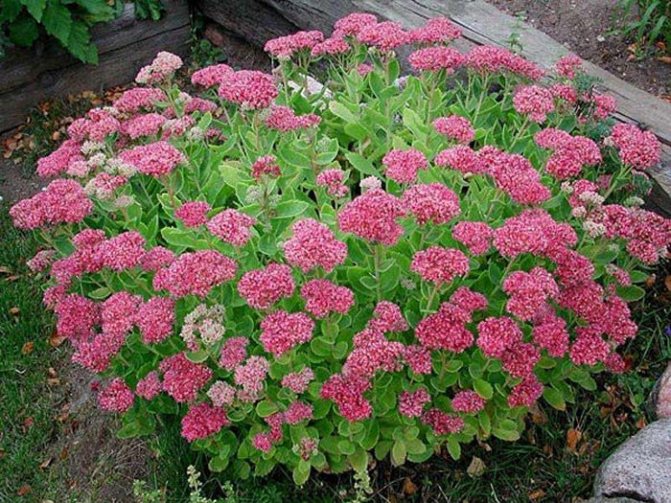

Diseases and pests
Sedum is one of those plants that are practically not exposed to diseases and pests. Improper care is often a provocateur for the development of bacteria.
Due to waterlogging, succulent damages rot. The main signs of the disease are gray or black spots on the entire surface. The areas affected by bacteria are cut off with a sharp knife and destroyed, and the sedum itself is sprayed with a fungicide. Watering is carried out only after the soil dries out.
Among insects, aphids, nematodes and weevils are dangerous for stonecrop.
- For small black pests that damage the leaves, plants are sprayed with a weak insecticide solution. Please note that a strong concentrate cannot be used, as it burns the delicate leaves.
- Nematodes live in the root and quickly destroy it. The appearance of unexpected guests can only be detected by the appearance of the above-ground part of the plant. Flowers with wilting foliage are dug up together with an earthen clod and taken away from the site.
- Weevils that eat fleshy leaves are collected in a bag and destroyed.
Growing methods in the Moscow region
The temperate climate is ideal for growing sedum. In the Moscow region, it is grown for decorative purposes in summer cottages, since the plant does not require frequent watering or any other complex care.
A unique feature lies in the ability to quickly take root, expanding the area of its growth. Some varieties are able to grow with a wide carpet, which hides minor flaws of the flower beds underneath.
Sow sedum or plant already formed bushes, preferably outdoors, he loves light.
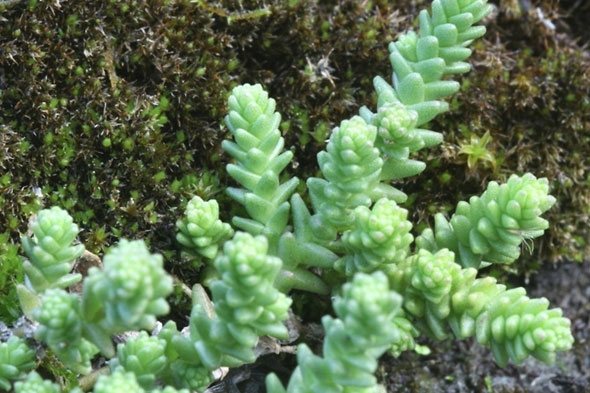

If desired, sedum can also be planted indoors in a pot. Most varieties have a horizontal root system, so it is important to choose shallow but wide pots.
For growing outdoors in the Moscow region, the following varieties are most suitable:
- Bent back;
- White;
- Caustic;
- Prominent;
- Siebold's Spanish;
- Evers.
The caustic sedum releases substances into the soil that inhibit the growth of weeds. There will be no weeds under its carpet, which is very convenient for summer residents.
Sedum in landscape design
Due to the fact that there are a large number of varieties with a wide variety of characteristics, sedum is often used for landscaping. Here's how sedum varieties are used:
- Low-growing and creeping varieties are planted in mixborders, on slides.
- Sedum ground cover is ideal for creating living flower carpets, framing borders and paths.
- Tall sedum varieties are planted in groups.
- Sedum is planted in pots and pots, which are hung on the porch and around the site.
Reproduction
The seed method is suitable for the primary cultivation of sedum.It is also used by experienced florists to develop new varieties. For propagation of varietal specimens, it is better to use vegetative methods.
Cuttings
More suitable for low-growing, ground cover plants. Before flowering or after, cut off the shoots about 8-10 cm long. Remove the lower leaves and plant the cuttings to root in loose soil. You need to deepen at least 1 internode. When the roots appear, transplant the cuttings to the site. You can harvest cuttings in the fall. They are rooted in water until spring, constantly changing it so that it does not stagnate. If rooting occurs even in winter, then the plants need to be planted in pots with soil, and in the spring, along with an earthen lump, plant on the site.
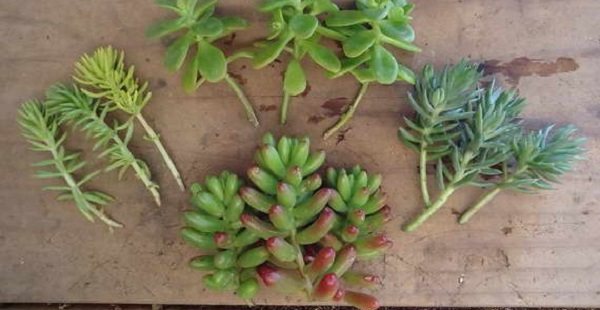

Dividing the bush
The method is suitable for tall adult stonecrop over 4 years old. In early spring, dig out a bush, remove excess soil from the roots. Divide it into parts, each should have roots and buds. Treat the sections with a fungicide and place the cuttings in a cool place to dry for a couple of hours. Plant them in holes the size of which corresponds to the size of the roots.
